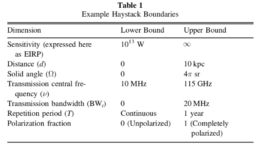Humanity’s search for signs of extraterrestrial intelligence has been underway, in one form or another, for decades. But how much searching have we really done?

The 100-meter Green Bank Telescope has been used to search for radio signals from extraterrestrial civilizations. It was also used to eavesdrop on signals from interstellar asteroid ‘Oumuamua in 2017. [NRAO/AUI/NSF]
Where Is Everybody?
With the number of known potentially habitable exoplanets increasing every day, it’s easy to feel both optimistic about and overwhelmed by our chances of finding life on other planets. The search for life elsewhere in the universe has led astronomers to carry out highly precise observations of exoplanet atmospheres in the hopes of detecting biosignatures — like the subtle imprint that gaseous oxygen and methane would leave on an exoplanetary spectrum.
The search for extraterrestrial intelligence (SETI), on the other hand, looks for technosignatures rather than biosignatures. Technosignatures could take many forms, like the excess waste heat emitted by structures designed to harness the energy of a star, but most SETI efforts focus on extraterrestrial radio signals. For all our decades of searching, we’ve yet to find any convincing signals, leading some to believe that there are no signals to be found.
Have we truly plumbed the depths of the cosmic ocean and come up empty-handed, meaning that we should abandon our search? To answer this question, a team led by Jason Wright (The Pennsylvania State University) devised a way to calculate how much of the available parameter space we’ve really searched.

The boundaries for the example haystack used in this work. Click to enlarge. [Wright, Kanodia & Lubar 2018]
Measuring n-dimensional Volumes
Wright and collaborators based their calculations on a concept called the cosmic haystack: a volume containing naturally occurring radio signals and (hopefully!) at least one artificial signal from an intelligent extraterrestrial civilization — the proverbial needle that rounds out the metaphor.
But quantifying our progress in the search for extraterrestrial intelligence is more complicated than just considering the fraction of the sky we’ve observed; the spatial volume surveyed is just one of the many dimensions of the cosmic haystack. Just as observing only a few stars would greatly limit the physical volume of your survey, only searching for signals in a narrow frequency range limits yet another dimension of the cosmic haystack.
In addition to the spatial volume, Wright and collaborators also included the sensitivity of the survey, the bandwidth, polarization, and modulation of the signal, and the repetition rate, as dimensions of the haystack. This makes for a searchable haystack with no fewer than nine dimensions! Based on reasonable search parameters, the authors estimate the total volume of the cosmic haystack to be 6.4 × 10116 m5 Hz2 s W-1.
More Than a Drop in the Bucket?
Of that immense volume, we’ve searched a mere 2.4 × 1098 m5 Hz2 s W-1, which amounts to a fraction of 3.8 × 10-19. This is equivalent to a small swimming pool’s worth of water compared to the volume of Earth’s oceans!
Feeling discouraged that after decades of listening, we’ve really only just begun our search? Carefully designed surveys — like those with wide fields of view that make repeated observations of each patch of sky — have the potential to quickly scour large swaths of the cosmic haystack. Hopefully, there are plenty of needles to be found.
Citation
“How Much SETI Has Been Done? Finding Needles in the n-dimensional Cosmic Haystack,” Jason T. Wright, Shubham Kanodia, and Emily Lubar 2018 AJ 156 260. doi:10.3847/1538-3881/aae099

3 Comments
Pingback: AAS Nova – New
Pingback: Searching for Alien Needles in the Cosmic Haystack – AstroBrief
Pingback: Searching for Alien Needles in the Cosmic Haystack – ScienceEye